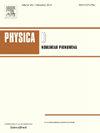Stabilizing optical solitons by frequency-dependent linear gain–loss and the collisional Raman frequency shift
IF 2.9
3区 数学
Q1 MATHEMATICS, APPLIED
引用次数: 0
Abstract
We study transmission stabilization against radiation emission for solitons of the nonlinear Schrödinger (NLS) equation (optical solitons) by frequency-dependent linear gain–loss and the collisional Raman frequency shift. For this purpose, we consider soliton propagation in nonlinear optical waveguides in the presence of weak linear gain–loss, cubic loss, and the collisional Raman frequency shift perturbation. We first show how the collisional Raman perturbation arises in three different nonlinear physical setups. We then show by numerical simulations with a perturbed NLS equation that transmission in waveguides with weak frequency-independent linear gain is unstable. The radiative instability is stronger than the radiative instabilities that were observed in all earlier studies of soliton propagation in the presence of weak linear gain, cubic loss, and various frequency-shifting physical mechanisms. Moreover, we demonstrate by numerical simulations with another perturbed NLS equation that transmission in waveguides with weak frequency-dependent linear gain–loss, cubic loss, and the collisional Raman frequency shift is stable, despite the stronger radiative instability in the corresponding waveguide setup with weak linear gain. Additionally, we find that stabilization occurs via the following process: the collisional Raman frequency shift of the soliton leads to partial separation of the soliton’s and the radiation’s Fourier spectra, while the frequency-dependent linear gain–loss leads to efficient suppression of radiation emission. Thus, our study significantly extends the range of applicability of the soliton stabilization method, by showing that the method works even when the radiative instability is strong.
利用频率相关线性增益损耗和碰撞拉曼频移稳定光孤子
利用频率相关的线性增益损耗和碰撞拉曼频移研究了非线性Schrödinger (NLS)方程孤子(光孤子)对辐射发射的传输稳定性。为此,我们考虑了存在弱线性增益损耗、三次损耗和碰撞拉曼频移扰动的非线性光波导中孤子的传播。我们首先展示了碰撞拉曼摄动如何在三种不同的非线性物理设置中产生。然后,我们用一个扰动NLS方程的数值模拟表明,在具有弱频率无关线性增益的波导中传输是不稳定的。辐射不稳定性比所有早期在弱线性增益、三次损耗和各种移频物理机制下观察到的孤子传播研究中的辐射不稳定性更强。此外,我们通过另一个扰动NLS方程的数值模拟证明了在具有弱频率相关线性增益损耗、三次损耗和碰撞拉曼频移的波导中传输是稳定的,尽管在相应的具有弱线性增益的波导设置中具有更强的辐射不稳定性。此外,我们发现稳定是通过以下过程发生的:孤子的碰撞拉曼频移导致孤子和辐射的傅立叶谱的部分分离,而频率相关的线性增益损失导致辐射发射的有效抑制。因此,我们的研究表明,即使在辐射不稳定性很强的情况下,该方法也有效,从而大大扩展了孤子稳定方法的适用范围。
本文章由计算机程序翻译,如有差异,请以英文原文为准。
求助全文
约1分钟内获得全文
求助全文
来源期刊

Physica D: Nonlinear Phenomena
物理-物理:数学物理
CiteScore
7.30
自引率
7.50%
发文量
213
审稿时长
65 days
期刊介绍:
Physica D (Nonlinear Phenomena) publishes research and review articles reporting on experimental and theoretical works, techniques and ideas that advance the understanding of nonlinear phenomena. Topics encompass wave motion in physical, chemical and biological systems; physical or biological phenomena governed by nonlinear field equations, including hydrodynamics and turbulence; pattern formation and cooperative phenomena; instability, bifurcations, chaos, and space-time disorder; integrable/Hamiltonian systems; asymptotic analysis and, more generally, mathematical methods for nonlinear systems.
 求助内容:
求助内容: 应助结果提醒方式:
应助结果提醒方式:


